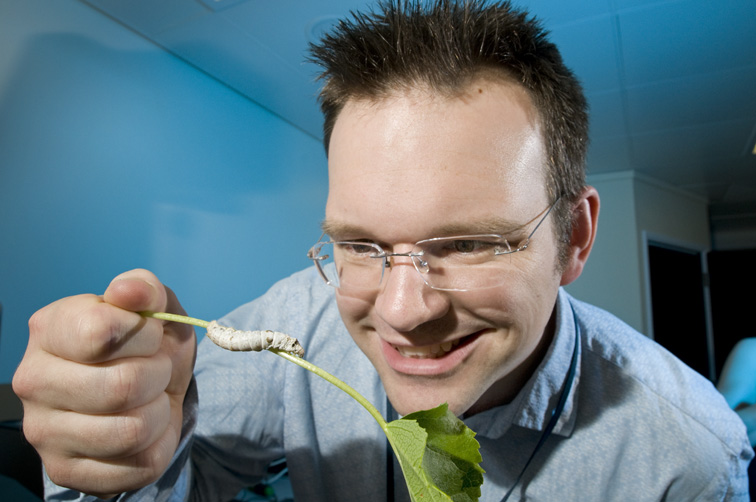The silk that spiders spin to make webs is a high performance material, being weight for weight stronger than steel and tougher than Kevlar, which is used in bullet-proof vests.
Collaboration between Dr Ann Terry at ISIS and Dr Chris Holland from the Oxford Silk Group has formed to solve the mechanism by which spiders and silkworms spin their silk, with aspirations of using similar methods to produce industrially important materials from naturally occurring polymers in the future.
Both spider and silkworm silks are formed as a protein feedstock travels down the animals’ silk gland and through its spinning duct. The experiments conducted at ISIS took silk proteins from within the silk glands of mulberry silkworms, Bombyx mori and subjected this feedstock to similar shearing forces using a machine known as a rheometer.
During the procedure, the samples were placed in the beamline of ISIS instrument Sans2d and the scattering of neutrons changed as the silk proteins interacted and coagulated into a silk fibre. The neutron measurements enabled the researchers to watch the silk coagulation process at molecular level, giving new insights into how it works. Research remains on-going as more and more information is gathered on the mechanical properties of silk and how these aqueous silk proteins at a high concentration convert into a solid silk fibre.
The ability to produce silk has evolved independently in many arthropod species, such as silkworms and spiders. The silk which we exploit to weave into textiles comes from the cocoons of the larvae of the mulberry silkworm, Bombyx mori, which they build around themselves for protection during metamorphosis into silk moths. When artificially grown for silk production, two thirds of the silkworm’s body is dedicated to silk production.

Chris Holland with a Mulberry Silkworm. The team looked at how the silkworms spin their silk for cocoons, using Sans2d.
View full-size image
In comparison, spiders have evolved silk production for a variety of reasons, each of which requires a unique type of silk. The most obvious is for spinning webs to catch prey, which came about after more than 40 million years of evolution, as spiders had to start catching aerial prey once insects had evolved flight. However some spiders remain on the ground, such as Trapdoor spiders (from the family, Ctenizidae) which ambush their prey once they disturb the ‘trip’ lines laid out by the spider.
Different behaviours and structural parts of the web require different types of silk which are produced from up to seven separate types of silk glands. The silk used for auxiliary spirals in a web differ from structural silks and those used for escape drag lines, as does silk used for the tough outer coat of an egg sack compared to the soft inner silk, inside the egg sack.
Did you know a cable made of spider silk which is no thicker than five centimeters diameter could support an airplane? Nature produces astounding materials, and if we can unpick millions of years of evolution to understand how these mechanisms developed over time, there is the possibility to make materials which were never possible before.
Emily Mobley
Chris Holland et al.
Research date: October 2012
Further Information
For further information, visit the Oxford Silk Group website:
http://users.ox.ac.uk/~abrg/spider_site/index.html
